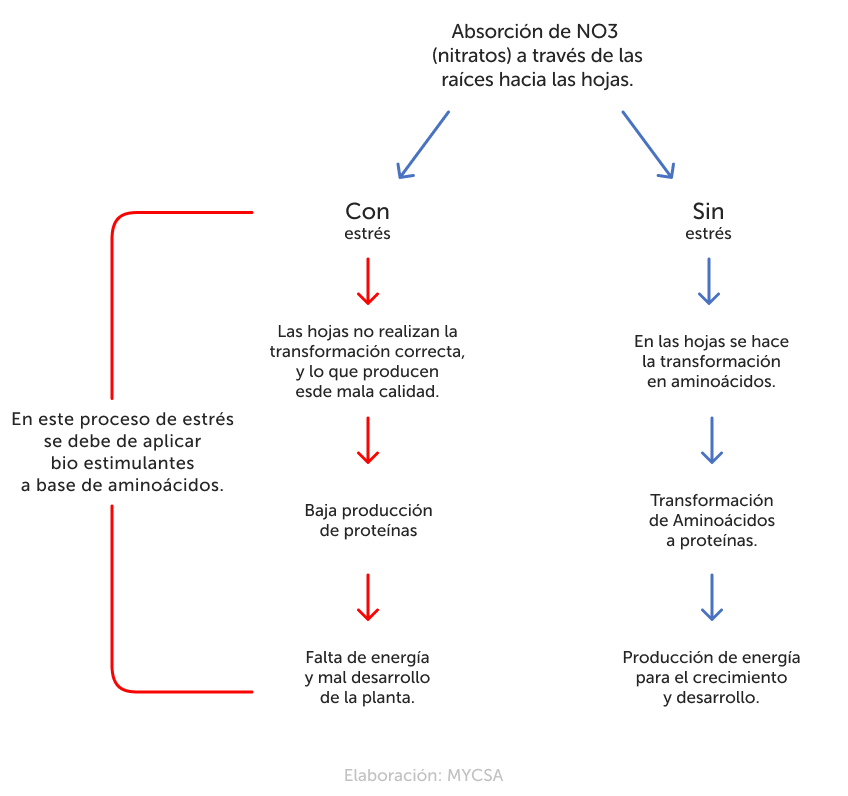Amino acids are molecules that function as a structural unit of proteins and peptides, so they have a vital importance in living beings, including plants, these synthesize amino acids from oxygen, carbon and hydrogen, some of the most important amino acids obtained are:
- Methionine
- Glutamate
- Arginine
- Alanine
- Glycine
The main activity of amino acids in the plant is growth and development, facilitating the correct absorption of nutrients (Table 1).

Table 1
The main functions carried out by amino acids are:
Antioxidant actions, which help proper nutrition avoiding premature aging of plants.
Mitigate the effects of stress caused by frost, excessive cold, heat for long periods or thermal shock (sudden changes in temperature), with thermal stress, plants may have difficulty producing amino acids with quality and in the right quantity.
To help plants in their development by correcting a possible deficit in amino acid production, growers are increasingly turning to biostimulants.
What are amino acid-based biostimulants and how do they work?
They are products composed of organic molecules that are obtained from the enzymatic or chemical hydrolysis of biological extracts, usually extracted from vegetables, the result is a balanced mixture of amino acids that generate a positive response to plants.
Amino acids act as energetic agents that are easily assimilated by the plant, producing positive stimuli and obtaining different benefits:
High temperature. L proline promotes the retention of more water in the cytoplasm of plant cells, glutamic acid reinforces the permeability of the cytoplasmic membrane to water stress. L-serine acts on aquaporins (specialized proteins) that regulate the entry of water into the plant at the cellular level, even when there are limitations to do so, while L-valine maintains the integrity of the cell membrane.
Low temperatures. One of the plant’s responses is to accumulate amino acids to weak points, which is why free amino acids are moved through the phloem to accumulate where the plant needs them. The main amino acid is L-proline whose function is to help reduce freezing damage.
Photosynthesis. L-glycine, L-alanine, L-glutamic acid and L-arginine improve chlorophyll production, which promotes the photosynthesis process and generates more photoassimilates, they also increase the amount of chlorophyll in the leaves, therefore the efficiency of light is better used.
In the absorption of nutrients it has been proven that amino acids improve the absorption of nutrients and water because they have a complexing action with nutrients. Amino acids with this effect are L-glutamic acid, L-glycine, and L-aspartic acid. Especially glutamic acid is the first amino acid formed after nitrogen absorption and improves nitrogen metabolism by means of the enzyme glutamine synthetase.
In summary, amino acids help us with the following:
- They facilitate proper crop development and growth.
- They mitigate the effects of thermal stress caused by excess or lack of water, wind, extreme or changing temperatures, hail, frost, salinity, etc.
- They prevent the plant from using an excess of energy that could weaken it or alter its metabolism when faced with an adverse situation.
- They improve fruit set.
- They achieve a better ratio of sugar and acidity in the plant (º Brix).
- Improve fruit size and coloration.
- They favor the production of phytohormones, essential for the control of ethylene growth, auxins and hormones involved in flowering.
- They enhance plant resistance to stress situations.
Amino acids can be applied either by foliar application or by irrigation. The choice of one or the other method will depend on the main objective of the application.
For example, if we want to stimulate root production, the recommended application is through irrigation, in addition to applying amino acids containing methionine, arginine, etc.
If, on the other hand, our intention is to promote, firstly, flowering and, subsequently, fruit set, it is advisable to apply by foliar application and to apply amino acids with a high content of glutamic acid, hydroxyproline, glycine, etc.
Literature consulted:
INTAGRI. 2018. Aminoácidos para la Bioestimulación de Cultivos Hortofrutícolas. Serie Nutrición Vegetal. Núm. 112. Artículos Técnicos de INTAGRI. México. 4 p.
Ing. Eduardo Morales Casas

